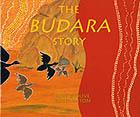This tranquil story is about the Yamajis people living near Barndiyarra Lake and Budara, a healer. Budara called two rock hills close by ‘Budara’ after himself, one being a man’s rock and the other a woman’s rock. The Yamajis people lived close by. Animals such as goannas, kangaroos and emu are in abundance while swans and ducks swim together in the lake. In summertime when the water dries up, the people and animals must travel a long way for food and water. One day, the swans and ducks are crying because they knew the Yamajis people are sick. They go to Budara, as a healer, to let him know. Budara visits the people’s camp, puts his hand on the heads of men, women and children, and they are healed.
The landscape shape of the book captures the peaceful and rich landscape and especially the details of family activities surrounded by water and plentiful birds and animals. The Wajarri text appears against a swirling olive green colour block at the left margin. The English translation appears on the opposite page against a rusty brown in a similar shaped swirl. The double page invites onlookers to pour over the many details of the Yamajis people’s way of life, including their appearance, weapons, tools, food and daily family activities. At the back of the book, there is an extensive word list comparing English and Wajarri. These words go beyond the story but relate to its content and could possibly encourage children to create stories. There is also a guide to pronouncing vowels and consonants.
Ross Boddington was born on Wooleen Station in the Murchison area. He learned the Wajarri language and many of their Dreamtime stories. Olive Boddington married Ross and through him gained knowledge of the Wajarri traditions. They dedicate this book to the Yamaji people of the Murchison who told them ‘The Budara Story’.

